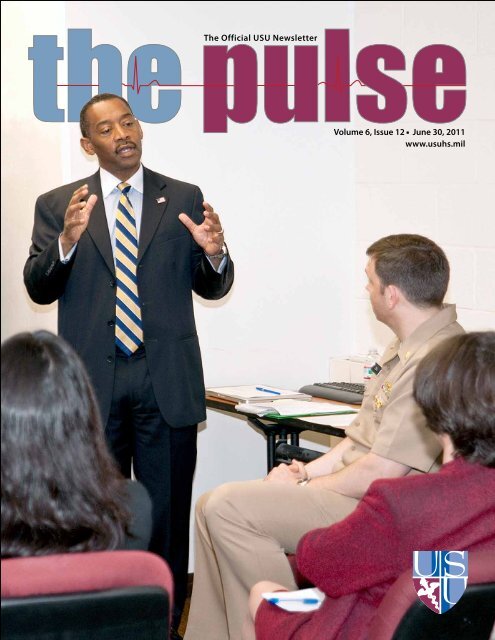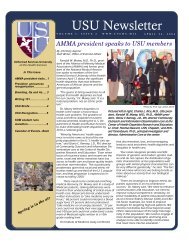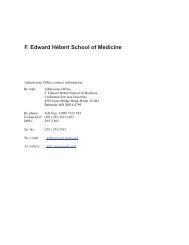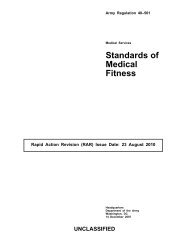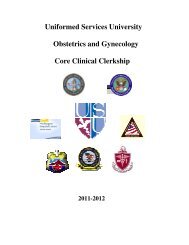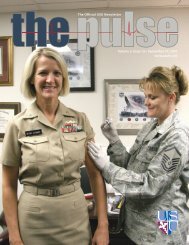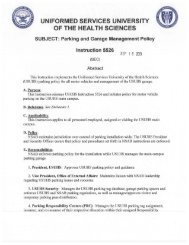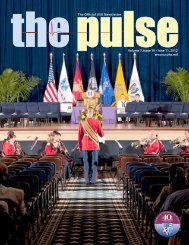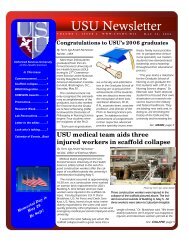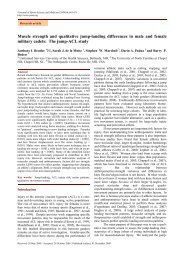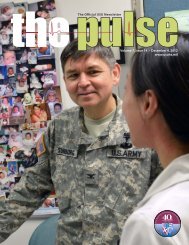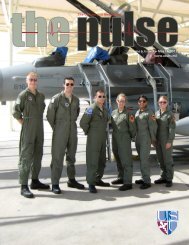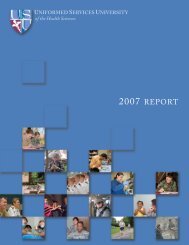Vol. 6, Issue 12 06/30/11 - Uniformed Services University of the ...
Vol. 6, Issue 12 06/30/11 - Uniformed Services University of the ...
Vol. 6, Issue 12 06/30/11 - Uniformed Services University of the ...
Create successful ePaper yourself
Turn your PDF publications into a flip-book with our unique Google optimized e-Paper software.
The Official USU Newsletter<br />
<strong>Vol</strong>ume 6, <strong>Issue</strong> <strong>12</strong> n June <strong>30</strong>, 20<strong>11</strong><br />
www.usuhs.mil
Sharon Willis<br />
Deputy Vice President for External<br />
Affairs and Managing Editor<br />
Ken Frager<br />
Public Affairs Specialist<br />
Staff Sgt. Mat<strong>the</strong>w Rosine<br />
Production Editor<br />
MC1 Chad Hallford<br />
Writer<br />
Christine Creenan-Jones<br />
Contributing Writer<br />
Lori Fields<br />
Layout and Design<br />
Production<br />
Editorial content is edited, prepared<br />
and provided by <strong>the</strong> USU Office <strong>of</strong><br />
External Affairs unless o<strong>the</strong>rwise<br />
indicated. The Pulse staff may<br />
include or exclude articles based<br />
upon news value, impact on <strong>the</strong><br />
university and space availability.<br />
Submissions<br />
The Pulse will be published<br />
bi-weekly on Mondays. The<br />
deadline for submissions is at 4 p.m.<br />
Tuesday prior to <strong>the</strong> publication<br />
date. Submissions can be sent to<br />
usunewsletter@usuhs.mil or by<br />
calling <strong>30</strong>1-295-0895.<br />
Photo by Thomas C. Balfour<br />
On <strong>the</strong> cover<br />
Dr. Jonathan Woodson, assistant<br />
secretary <strong>of</strong> Defense for Health Affairs<br />
discussed health policy within <strong>the</strong> Military<br />
Health System and throughout <strong>the</strong> federal<br />
government with USU’s Masters <strong>of</strong> Health<br />
Administration and Policy (MHAP)<br />
students during his recent campus<br />
visit. (See story page 7)<br />
With years <strong>of</strong> training to go,<br />
students are told <strong>the</strong>ir impact on<br />
patients starts today<br />
by Ken Frager<br />
Photo by Ken Frager<br />
Army Maj. (Dr.) Aaron Holley (SoM, 2001), addressed students and guests during<br />
<strong>the</strong> Class <strong>of</strong> 2014 White Coat ceremony.<br />
A rite <strong>of</strong> passage for medical<br />
students, <strong>the</strong> donning <strong>of</strong> <strong>the</strong> white<br />
coat, while symbolic in nature,<br />
provides a psychological transition<br />
that carries significance. At USU,<br />
under crystal blue skies recently,<br />
first year medical students made that<br />
transition, pinning <strong>the</strong> Gold Seal<br />
<strong>of</strong> Humanism on <strong>the</strong>ir stark white<br />
coats and stepped into <strong>the</strong> world <strong>of</strong><br />
medicine.<br />
“Even though you have years<br />
<strong>of</strong> training to go, your impact on<br />
patients starts today,” said Army Maj.<br />
(Dr.) Aaron Holley (SoM, 2001),<br />
<strong>the</strong> guest speaker for <strong>the</strong> Class <strong>of</strong><br />
2014 ceremony. “You need to take<br />
it seriously, because many <strong>of</strong> your<br />
patients will hang on every word<br />
you say now. Your answers, your<br />
guidance and your overall interactions<br />
with <strong>the</strong>m will <strong>of</strong>ten be <strong>the</strong><br />
most beneficial treatment <strong>the</strong>y<br />
receive during a given visit. You<br />
will shape <strong>the</strong>ir perceptions <strong>of</strong> <strong>the</strong>ir<br />
medical care and <strong>the</strong>ir personal<br />
health. Doing so appropriately and<br />
effectively,” he added, “is every bit<br />
as important as being technically<br />
precise during a surgery, or following<br />
evidence-based guidelines when<br />
prescribing a medication.”<br />
Army Col. (Dr.) Lisa Moores<br />
(SoM, 1989) and assistant dean for<br />
Clinical Sciences, who welcomed<br />
guests to <strong>the</strong> ceremony, recalled why<br />
<strong>the</strong> symbolic gesture <strong>of</strong> <strong>the</strong> white<br />
coat is so meaningful. “Besides<br />
presenting <strong>the</strong> opportunity for<br />
students to recite <strong>the</strong> Hippocratic<br />
Oath for <strong>the</strong>ir first time, <strong>the</strong> White<br />
Coat Ceremony is really a symbol <strong>of</strong><br />
<strong>the</strong> combination <strong>of</strong> <strong>the</strong> pr<strong>of</strong>ession<br />
<strong>of</strong> medicine. We are scientists, but<br />
we also are humanistic. Finding <strong>the</strong><br />
right mix makes us better doctors<br />
and students need to understand<br />
<strong>the</strong> depth <strong>of</strong> responsibility <strong>the</strong>y are<br />
taking on.”<br />
2 <strong>the</strong> pulse June <strong>30</strong>, 20<strong>11</strong>
Using Technology To Combat Prostate Cancer<br />
by Ken Frager and Jennifer Cullen, Ph.D., MPH<br />
As treatments for prostate disease<br />
have advanced over<br />
<strong>the</strong> past decade,<br />
so has <strong>the</strong> level <strong>of</strong><br />
knowledge in <strong>the</strong><br />
medical research<br />
community on <strong>the</strong><br />
impact <strong>of</strong> new <strong>the</strong>rapeutic<br />
approaches on disease outcomes<br />
such as quality <strong>of</strong> life and survival.<br />
Prostate cancer is <strong>the</strong> leading type<br />
<strong>of</strong> newly-diagnosed malignancy in U.S.<br />
men but very little is known about its<br />
prevention, and controversy exists as<br />
to whe<strong>the</strong>r <strong>the</strong>re is overscreening and<br />
overtreatment <strong>of</strong> this disease. More<br />
extensive research is needed to understand<br />
disease development and better<br />
identify and treat men whose disease<br />
will ultimately act aggressively.<br />
The Center for Prostate Disease<br />
Research, a program <strong>of</strong> <strong>the</strong> <strong>Uniformed</strong><br />
<strong>Services</strong> <strong>University</strong> <strong>of</strong> <strong>the</strong> Health<br />
Sciences and <strong>the</strong> Henry M. Jackson<br />
Foundation, created a multicenter<br />
national database to collect comprehensive<br />
data from leading Defense<br />
Department and civilian medical<br />
centers, including Madigan Army<br />
Medical Center, Naval Medical Center<br />
San Diego, Walter Reed Army Medical<br />
Center, and Virginia Mason Medical<br />
Center. The database is designed to<br />
advance knowledge and understanding<br />
<strong>of</strong> prostate disease, particularly prostate<br />
cancer, and to allow for <strong>the</strong> development<br />
<strong>of</strong> more effective prevention,<br />
diagnostic and treatment strategies for<br />
this cancer.<br />
“This database has allowed researchers<br />
to capture relevant data points and<br />
link <strong>the</strong>m to patient outcomes,” said<br />
Jennifer Cullen, Ph.D., MPH, director <strong>of</strong><br />
<strong>the</strong> Epidemiological Research Program<br />
at CPDR and research assistant pr<strong>of</strong>essor<br />
in <strong>the</strong> Department <strong>of</strong> Surgery at USU.<br />
Congress established <strong>the</strong> CPDR in<br />
1991 under <strong>the</strong> leadership <strong>of</strong> Col. (ret.)<br />
David G. McLeod, M.D., <strong>the</strong> current<br />
director <strong>of</strong> CPDR and urologic oncologist<br />
at Walter Reed Army Medical<br />
Center, to combat increasing prostate<br />
cancer incidence. This unique center<br />
integrates basic and clinical science<br />
expertise to develop refined detection<br />
techniques and promising treatments<br />
for prostate disease.<br />
The clinical database contains information<br />
from more than 25,000 men<br />
who have been biopsied for suspicion <strong>of</strong><br />
prostate cancer based on <strong>the</strong>ir prostate<br />
specific antigen (PSA) value, DRE result,<br />
and/or symptoms and connects all pieces<br />
<strong>of</strong> <strong>the</strong> center, including clinical trials,<br />
basic science and epidemiologic research.<br />
“Ultimately, <strong>the</strong>se data will help us to<br />
focus on quality <strong>of</strong> life during <strong>the</strong> survivorship<br />
period, as well as o<strong>the</strong>r ‘holy grail’<br />
endpoints like patient survival, which is <strong>of</strong><br />
enormous interest to us as we support <strong>the</strong><br />
military community,” Cullen said.<br />
According to Cullen, some <strong>of</strong> <strong>the</strong><br />
areas already identified as needing<br />
additional study relate to racial/<br />
ethnic disparities in treatment<br />
outcomes, identifying predictors <strong>of</strong><br />
metastasis and better understanding<br />
<strong>the</strong> impact <strong>of</strong> disease among Asian<br />
and Hispanic Americans.<br />
“Because <strong>the</strong>re is a greater proportion<br />
<strong>of</strong> African Americans in <strong>the</strong><br />
Top DoD physician joins <strong>the</strong> troops<br />
by Ken Frager<br />
Photo by Thomas C. Balfour<br />
Army SFC Ronald Wilson, Army Senior<br />
Enlisted Advisor, inspects Dr. Jonathan<br />
Woodson’s Swiss seat rappelling<br />
harness in advance <strong>of</strong> <strong>the</strong> DoD’s senior<br />
physician’s “train-up” experience on <strong>the</strong><br />
USU rappel wall.<br />
military as compared to <strong>the</strong> nation as a<br />
whole, we can dig deeper and examine<br />
this subgroup in greater detail,” Cullen<br />
said, adding that examining outcomes<br />
such as prostate-specific mortality and<br />
overall survival require a very large<br />
sample size and long-term follow up..<br />
The current data have been collected<br />
since 1992, and provide a breadth <strong>of</strong><br />
clinical characteristics.<br />
The database has propelled <strong>the</strong><br />
CPDR Basic Science Program in<br />
a leadership role in translational<br />
research focusing on discovery and<br />
evaluation <strong>of</strong> novel biomarkers and<br />
<strong>the</strong>rapeutic targets much needed<br />
to enhance prognosis and targeted<br />
<strong>the</strong>rapy <strong>of</strong> prostate cancer.<br />
“The primary strength <strong>of</strong> <strong>the</strong> database<br />
is that it is a resource that will help us<br />
answer tough questions about how best<br />
to tailor specific treatments to patients<br />
and provide advice regarding <strong>the</strong> risk <strong>of</strong><br />
prostate disease progression,” Cullen said.<br />
“Without this resource in our arsenal, we<br />
couldn’t answer many <strong>of</strong> <strong>the</strong>se questions<br />
or address <strong>the</strong>se issues effectively.”<br />
In preparation for <strong>the</strong> upcoming<br />
deployment to Ft. Indiantown Gap, Pa.,<br />
where medical and graduate nursing<br />
students will participate in <strong>the</strong> Kerkesner<br />
and Bushmaster Field Training Exercises,<br />
as part <strong>of</strong> USU’s military unique curriculum,<br />
Dr. Jonathan Woodson, assistant<br />
secretary <strong>of</strong> defense for health affairs<br />
decided it was time to “get out in <strong>the</strong> field<br />
with <strong>the</strong> troops.” After <strong>of</strong>fering leadership<br />
advice to <strong>the</strong> students, and with <strong>the</strong><br />
Pentagon and Military Channel cameras<br />
rolling, <strong>the</strong> Army Reserves Brigadier<br />
General rappelled down <strong>the</strong> 63-foot<br />
Building A rappel tower. “As a prior<br />
commander, I believe it’s always good to<br />
get out in <strong>the</strong> field with <strong>the</strong> troops,” said<br />
Dr. Woodson. “And I think commanders<br />
always need to demonstrate to <strong>the</strong> troops<br />
that <strong>the</strong>y are willing to do everything you<br />
ask <strong>the</strong>m to do.” Operations Kerkesner<br />
and Bushmaster kick-<strong>of</strong>f July 10 and run<br />
through July 21.<br />
The Official USU Newsletter 3
USU dental program faces injury through artistic methods<br />
by Christine Creenan-Jones<br />
Lieutenant Commander William<br />
Wilson, D.D.S., a dentist from Charleston,<br />
WV, has treated hundreds <strong>of</strong><br />
injuries over <strong>the</strong> years. His patients,<br />
many <strong>of</strong> <strong>the</strong>m wounded in combat,<br />
have lost teeth, eyes, ears and o<strong>the</strong>r<br />
body parts. Making <strong>the</strong>se wounded<br />
warriors whole again is both an art<br />
and science involving skills Wilson has<br />
mastered over <strong>the</strong> years.<br />
The naval <strong>of</strong>ficer, who is part <strong>of</strong><br />
a growing field called maxill<strong>of</strong>acial<br />
pros<strong>the</strong>tics, has been creating realistic<br />
facial implants from jars <strong>of</strong> silicone and<br />
tubes <strong>of</strong> paint for much <strong>of</strong> his military<br />
career. The complex process is creative<br />
and precise, intuitive and systematic,<br />
with hundreds <strong>of</strong> work hours going into<br />
each pros<strong>the</strong>sis.<br />
Though <strong>of</strong>ten tedious, Wilson is passionate<br />
about his craft and enjoys teaching USU<br />
students his art at <strong>the</strong> Naval Postgraduate<br />
Dental School in Be<strong>the</strong>sda.<br />
“Maxill<strong>of</strong>acial pros<strong>the</strong>tics is a fascinating<br />
subspecialty,” he said. “Experts<br />
in this field work hard to improve<br />
lives and restore confidence to some<br />
<strong>of</strong> America’s greatest heroes. Educating<br />
<strong>the</strong> new generation to take on this<br />
Canadian Surgeon General visit<br />
Photo by Thomas C. Balfour<br />
challenge has been very rewarding for<br />
me, because I’m passing on important<br />
skills to help mend our fighting force.”<br />
Mending <strong>the</strong>m <strong>of</strong>ten means not just<br />
providing medically necessary care,<br />
but also finding ways to pros<strong>the</strong>tically<br />
restore <strong>the</strong> physical imperfections<br />
that bo<strong>the</strong>r servicemembers and <strong>the</strong>ir<br />
Photo by Ken Frager<br />
Commodore H.W. Jung,<br />
Surgeon General/<br />
Commander Canadian<br />
Forces Health <strong>Services</strong><br />
Group/Director General<br />
Health <strong>Services</strong>,<br />
presented USU president<br />
Charles L. Rice with a<br />
book describing <strong>the</strong><br />
history <strong>of</strong> <strong>the</strong> Canadian<br />
Military during<br />
Commodore Jung’s recent<br />
visit to <strong>the</strong> USU campus.<br />
Lieutenant Commander William Wilson,<br />
D.D.S., chairman <strong>of</strong> <strong>the</strong> Maxill<strong>of</strong>acial<br />
Pros<strong>the</strong>tics Program at USU’s Naval<br />
Postgraduate Dental School is part <strong>of</strong><br />
a unique specialty designed to treat<br />
patients with large oral defects or<br />
extraoral defects. Typical pros<strong>the</strong>tic<br />
devices replace missing eyes, ears,<br />
noses, jaw bones, etc.<br />
families. So, Wilson teaches his pupils<br />
to create syn<strong>the</strong>tic ears with realistic<br />
folds, cheek implants that careen “just<br />
right,” and arched noses that mirror<br />
<strong>the</strong> real thing.<br />
Once finished, <strong>the</strong> perfectly sculpted<br />
fabrications are held in place by powerful<br />
magnets. When done right, pros<strong>the</strong>ses<br />
fit like a glove, and <strong>the</strong> boundary<br />
between flesh and silicone is a nearseamless<br />
transition.<br />
“Experts in my field have done<br />
an amazing job at hiding some<br />
pretty severe injuries,” Wilson said.<br />
“Through this work – this art – we<br />
are returning dignity and function<br />
to patients who have had <strong>the</strong>irs<br />
taken away.” Wilson adds that his<br />
team, which also sees patients with<br />
facial differences from oncologic<br />
(cancer) treatments or congenitally,<br />
are successful because <strong>of</strong> <strong>the</strong>ir<br />
team-focused approach to care,<br />
and includes an extremely talented<br />
enlisted staff.<br />
But Wilson has discovered<br />
that a warrior’s pride isn’t always<br />
expressed through traditional<br />
mediums. Some patients showcase<br />
<strong>the</strong>ir injuries like prizes and request<br />
an ornamental pros<strong>the</strong>sis like<br />
silicon eyes emblazed with service<br />
emblems or sporting logos.<br />
“We’ll do pretty much anything for<br />
our patients,” he said. “Sculpting a<br />
whimsical piece is our way <strong>of</strong> decorating<br />
a hero.”<br />
His designs –whe<strong>the</strong>r natural or<br />
fanciful – create a higher quality <strong>of</strong> life<br />
for servicemembers while putting a<br />
new face on modern dental medicine.<br />
4 <strong>the</strong> pulse June <strong>30</strong>, 20<strong>11</strong>
HPRC Health Tips<br />
The Human Performance<br />
Resource Center Health Tips is a<br />
new column intended to provide <strong>the</strong><br />
USU community with information to<br />
help develop and maintain a healthy<br />
lifestyle. Check out <strong>the</strong> HPRC website<br />
at: http://humanperformancere<br />
sourcecenter.org.<br />
Type <strong>of</strong> self-talk impacts<br />
performance<br />
Many studies have found that<br />
“self-talk”—words or phrases about<br />
yourself that you state in your<br />
mind—significantly impacts performance,<br />
for better or worse. In a<br />
study to be published in Perspectives<br />
in Psychological Science, researchers<br />
looked at various types <strong>of</strong> self-talk<br />
and how <strong>the</strong>y affected subsequent<br />
performance. They found that<br />
instructional self-talk, such as telling<br />
yourself “elbows up” while you’re<br />
swimming, works best when you<br />
are trying to improve a technical<br />
aspect <strong>of</strong> a task. For tasks requiring<br />
endurance, strength, or confidence,<br />
motivational self-talk such as “I can<br />
do it!” is most effective.<br />
Sleep Apnea and Athletic<br />
Performance<br />
Sleep apnea is a disorder caused<br />
by <strong>the</strong> decrease or pause in <strong>the</strong><br />
airflow or breathing during sleep.<br />
It can lead to daytime sleepiness,<br />
fatigue, and cognitive impairment,<br />
all side effects that could negatively<br />
impact athletic performance.<br />
NBA superstar Shaquille O’Neal<br />
recently announced that he will<br />
retire from pr<strong>of</strong>essional basketball<br />
after 19 seasons and four championship<br />
rings. In addition to that<br />
announcement, O’Neal announced<br />
via a YouTube video that he, like <strong>12</strong><br />
million o<strong>the</strong>r Americans, had been<br />
diagnosed with sleep apnea.<br />
According to his girlfriend, <strong>the</strong><br />
seven-feet-tall, <strong>30</strong>0-plus-pounds<br />
center snored excessively during<br />
<strong>the</strong> night, and she noticed that his<br />
chest would <strong>of</strong>ten cease movement<br />
entirely. After participating in a<br />
Harvard <strong>University</strong>–sponsored sleep<br />
study, he was diagnosed with a mild<br />
case <strong>of</strong> sleep apnea and was advised<br />
to begin wearing a CPAP (Continuous<br />
Positive Airway Pressure) mask,<br />
a respiratory ventilation <strong>the</strong>rapy that<br />
assists <strong>the</strong> wearer’s breathing while<br />
asleep. O’Neal’s story has a happy<br />
ending—because <strong>of</strong> <strong>the</strong> recent diagnosis<br />
and subsequent treatment, O’Neal<br />
reports that he feels more energetic<br />
and that his overall quality <strong>of</strong> life<br />
has improved. He is also happy and<br />
comfortable with <strong>the</strong> treatment. O<strong>the</strong>r<br />
pr<strong>of</strong>essional athletes suffering from<br />
sleep apnea have not been so fortunate.<br />
In 20<strong>06</strong>, Reggie White, defensive<br />
end for <strong>the</strong> Philadelphia Eagles and<br />
Green Bay Packers—one <strong>of</strong> <strong>the</strong> greatest<br />
players in football history—reportedly<br />
died from causes related to sleep apnea.<br />
What exactly is sleep apnea? And<br />
how does it affect athletic performance?<br />
People with untreated sleep apnea stop<br />
breathing repeatedly during <strong>the</strong>ir sleep,<br />
sometimes hundreds <strong>of</strong> times during <strong>the</strong><br />
night and <strong>of</strong>ten for a minute or longer.<br />
According to <strong>the</strong> American Sleep Apnea<br />
Association, <strong>the</strong>re are three types <strong>of</strong><br />
apnea: obstructive, central, and mixed.<br />
Of <strong>the</strong> three types, obstructive sleep<br />
apnea (OSA) is <strong>the</strong> most common.<br />
Weight can contribute to sleep apnea.<br />
In 2009, a study by Sweden’s Karolinska<br />
Institute showed that overweight and<br />
obese men who lost weight during a<br />
calorie-restricted diet over nine weeks<br />
had major improvements in <strong>the</strong>ir sleep<br />
apnea symptoms.<br />
O<strong>the</strong>r risk factors for obstructive<br />
sleep apnea include certain physical<br />
attributes, such as having a thick neck<br />
(which describes many athlete body<br />
types), deviated septum, receding chin,<br />
and enlarged tonsils or adenoids. Allergies<br />
or o<strong>the</strong>r medical conditions that<br />
cause nasal congestion and blockage can<br />
also contribute to sleep apnea.<br />
Signs <strong>of</strong> sleep apnea include loud<br />
and chronic snoring, choking, snorting,<br />
or gasping during sleep, long pauses<br />
in breathing, and daytime sleepiness<br />
regardless <strong>of</strong> how much time you spend<br />
sleeping. O<strong>the</strong>r common signs and<br />
symptoms <strong>of</strong> sleep apnea include<br />
waking up with a dry mouth or sore<br />
throat, morning headaches, restless<br />
or fitful sleep, insomnia or nighttime<br />
awakenings, going to <strong>the</strong> bathroom<br />
frequently during <strong>the</strong> night, waking<br />
up feeling out <strong>of</strong> breath, forgetfulness<br />
and difficulty concentrating, moodiness,<br />
irritability, or depression.<br />
Untreated, sleep apnea can cause<br />
high blood pressure and o<strong>the</strong>r cardiovascular<br />
diseases, memory problems,<br />
weight gain, impotency, and<br />
headaches. Moreover, left untreated,<br />
it may be responsible for job impairment<br />
and motor vehicle crashes.<br />
In terms <strong>of</strong> athletic/sports performance,<br />
sleep apnea is a major<br />
concern because sleep apnea causes a<br />
disruption to healthy sleep patterns,<br />
which in turn can affect physical<br />
performance. According to a 2007<br />
Stanford <strong>University</strong> study <strong>of</strong> sleep and<br />
athletic performance, athletes who<br />
extend <strong>the</strong> amount <strong>of</strong> sleep <strong>the</strong>y get<br />
and reduce <strong>the</strong>ir sleep debt are more<br />
likely to improve <strong>the</strong>ir performance.<br />
Conversely, if an athlete does not get<br />
a good night’s sleep, <strong>the</strong>n <strong>the</strong> next<br />
day he/she is tired, sleepy, or irritable.<br />
In such cases, physical performance<br />
also is impaired, since <strong>the</strong>re is limited<br />
energy reserve due to <strong>the</strong> lack <strong>of</strong><br />
adequate or good-quality sleep. Sleep<br />
apnea not only has an impact on<br />
athletes—it affects <strong>the</strong> military, as<br />
well. According to a 2010 article in<br />
Military Times, data from <strong>the</strong> Armed<br />
Forces Health Surveillance Center<br />
show that 3,563 active-duty members<br />
had <strong>the</strong> disease in 2000, while 20,435<br />
were diagnosed in 2009.<br />
So what can you do if you suspect<br />
that you or your sleep partner has<br />
sleep apnea? The only way to be sure<br />
is to undergo a sleep test, which is<br />
done in a sleep lab where patients<br />
sleep in a special bedroom with<br />
electrodes and o<strong>the</strong>r sensors attached<br />
to various parts <strong>of</strong> <strong>the</strong> body. There,<br />
you will be monitored throughout <strong>the</strong><br />
night to keep track <strong>of</strong> whe<strong>the</strong>r and<br />
how <strong>of</strong>ten you stop breathing, how<br />
low your O2 sat (oxygen saturation)<br />
goes, and what your brainwaves are<br />
doing while you’re sleeping.<br />
The Official USU Newsletter 5
USU faculty member awarded The Legion <strong>of</strong> Merit<br />
by Ken Frager<br />
Retired Army Colonel (Dr.) Jeffrey<br />
L. Jackson, was awarded <strong>the</strong> Legion <strong>of</strong><br />
Merit medal by USU president (Dr.)<br />
Charles L. Rice, on behalf <strong>of</strong> U.S. Army<br />
Surgeon General Eric B. Schoomaker.<br />
That’s a wrap: USU Audio/Visual<br />
by Chad Hallford<br />
Courtesy Photo<br />
The presentation was made at <strong>the</strong><br />
Clement J. Zablocki Veterans Affairs<br />
Medical Center in Milwaukee, Wisc.,<br />
where Dr. Jackson is currently director<br />
<strong>of</strong> <strong>the</strong> General Medicine section.<br />
“A prolific publisher in internationally<br />
recognized and peer-reviewed<br />
journals and publications, Col.<br />
Jackson’s leadership and knowledge<br />
helped to streng<strong>the</strong>n USU’s reputation<br />
within <strong>the</strong> civilian and military<br />
medical research communities,” said<br />
Dr. Rice. “His contributions and<br />
commitment won’t soon be forgotten.”<br />
Col. Jackson was recognized for<br />
exceptionally meritorious service<br />
between September 1999 and<br />
October 2009, culminating as director,<br />
Division <strong>of</strong> Internal Medicine<br />
at USU. Col. Jackson has been a<br />
highly valued faculty member and<br />
full pr<strong>of</strong>essor <strong>of</strong> Medicine at <strong>the</strong><br />
USU and at <strong>the</strong> Walter Reed Army<br />
Medical Center, establishing a<br />
national reputation as an exemplary<br />
scholar and medical educator. He is<br />
also a 1996 graduate <strong>of</strong> USU’s Master<br />
<strong>of</strong> Public Health program.<br />
The Office <strong>of</strong> <strong>the</strong> Vice President for<br />
External Affairs, which includes <strong>University</strong><br />
Media <strong>Services</strong>, provides a range<br />
<strong>of</strong> video and audio services, thanks to<br />
<strong>the</strong> team <strong>of</strong> Willie Allen (retired Navy<br />
Photographer’s Mate 1st Class) and<br />
Army Spec. Ernest Sivia, III.<br />
“The <strong>University</strong> faculty, staff and<br />
students may not realize <strong>the</strong> capabilities<br />
we have available to help create<br />
6 <strong>the</strong> pulse June <strong>30</strong>, 20<strong>11</strong><br />
Photo by Ken Frager<br />
training videos, informational<br />
documentaries, or story telling,” said<br />
Allen. “We can work with you, discuss<br />
<strong>the</strong> projects in depth and develop a<br />
vision for <strong>the</strong> end product.”<br />
Along with video support, <strong>the</strong> team<br />
can develop products for use as inserts<br />
in presentations, provide mass duplication<br />
<strong>of</strong> media, media conversion,<br />
and audio (live speaker) output and<br />
recording capabilities.<br />
“We can provide an 8-microphone<br />
set up with quality speaker sound and<br />
recording for transcript capabilities,”<br />
said Allen. “This is ideal for board<br />
meetings or small conferences where a<br />
clear recording is desired.”<br />
“Our end product <strong>of</strong>ten tells USU’s<br />
story from an educational or historical<br />
perspective,” said Sivia, whose most<br />
recent assignment was with <strong>the</strong> 55th<br />
Signal Company (Combat Camera) at<br />
Ft. Meade, Md. “When we can accomplish<br />
this for our customers, it reflects<br />
back on us in such a rewarding way,”<br />
If you have an assignment or would<br />
like to discuss a project contact <strong>the</strong><br />
Multimedia team at 295-9395 or stop<br />
by <strong>the</strong>ir ground floor location in room<br />
G070.
Technology Update<br />
by Dennis Stutz<br />
The OCIO is currently working on<br />
<strong>the</strong> following items and wanted to<br />
bring you up to date on our progress.<br />
1. Sakai/Blackboard<br />
On June 2, 20<strong>11</strong>, <strong>the</strong> USU formally<br />
ended our use <strong>of</strong> Blackboard. More<br />
than 1,500 courses and 8,000 students<br />
and faculty used Blackboard since GSN<br />
pioneered <strong>the</strong> system.<br />
Since November 2010, <strong>the</strong> Sakai<br />
Migration migrated/created 389 new<br />
course sites and 94 new project sites to<br />
support students and faculty at <strong>the</strong> USU.<br />
The migration accounts for all active<br />
sites on Blackboard and <strong>the</strong> last version<br />
<strong>of</strong> a course. The remaining sites will be<br />
archived and stored at USU.<br />
There are now 242 Sakai course directors<br />
and 647 faculty accounts. There also<br />
are 1,172 student accounts, with courses<br />
or project sites for medical courses and<br />
all GSN, PMB, MPO and BID students.<br />
Thanks to faculty and students<br />
who supported <strong>the</strong> transition to<br />
Sakai, along with Mr. Hanson and<br />
<strong>the</strong> Sakai team (Tony Chen, 1LT Sean<br />
Baker, Bob Shimokaji, Jeb Miller,<br />
Willy Connor, Meredith Seibert), and<br />
kept everything on schedule. Their<br />
effort and input continue to improve<br />
<strong>the</strong> product.<br />
We will announce a series <strong>of</strong> new<br />
features over <strong>the</strong> coming months and<br />
work aggressively to integrate Sakai<br />
with current and future USU Registrar<br />
functions.<br />
2. IATO/ATO<br />
USU has a signed Interim Authority<br />
To Operate (IATO) in place as <strong>of</strong> June<br />
13, 20<strong>11</strong>. DISA FSO has a team on site<br />
until July 1. During this assessment,<br />
NOC, ATD, and CSD personnel may<br />
be pulled away from routine support<br />
calls to facilitate DISA inspector needs.<br />
Every effort will be made to minimize<br />
customer impact. This final assessment<br />
and mitigation will result in USU<br />
obtaining a full Authority To Operate<br />
(ATO) in mid-August. With Blackboard<br />
to Sakai migration complete and a<br />
DIACAP ATO in-hand, <strong>the</strong> OCIO will<br />
<strong>the</strong>n focus on <strong>the</strong> third and final major<br />
project for 20<strong>11</strong>, .edu migration.<br />
3. Using AKO for File Storage<br />
Did you know that in Organizational<br />
areas in AKO you have unlimited file<br />
storage space and you can drag and<br />
drop multiple files and folders into your<br />
AKO files area?<br />
Using <strong>the</strong> AKO WebDAV feature,<br />
you have your own virtual drive, similar<br />
to a network drive, where you can<br />
access <strong>the</strong> entire AKO file structure.<br />
You don’t need to be logged in to AKO<br />
and no longer need to use <strong>the</strong> AKO files<br />
interface to place documents into your<br />
AKO folders. WebDAV allows users to<br />
collaboratively edit and manage files on<br />
remote Web servers. AKO also provides<br />
a central resource for documentation.<br />
To learn how to take advantage <strong>of</strong> this<br />
Military medical leaders share wisdom<br />
with graduate students<br />
Ken Frager<br />
During his recent visit to USU, Dr.<br />
Jonathan Woodson, assistant secretary<br />
<strong>of</strong> Defense for Health Affairs, imparted<br />
some wisdom related to health policy<br />
in <strong>the</strong> Military Health System and<br />
throughout <strong>the</strong> federal government on<br />
<strong>the</strong> Masters <strong>of</strong> Health Administration<br />
and Policy (MHAP) students.<br />
“We have benefitted from several<br />
major visits recently,” said Navy<br />
Cmdr. Glen Diehl, assistant pr<strong>of</strong>essor<br />
and program coordinator. “These<br />
senior leaders, who cross all branches<br />
<strong>of</strong> service, provide background and<br />
guidance directly related to our<br />
feature, read <strong>the</strong> document at https://<br />
www.us.army.mil/suite/doc/<strong>30</strong>139673<br />
4. Discounts<br />
Discounts are available for USU<br />
faculty, students and staff to purchase<br />
Micros<strong>of</strong>t and Adobe s<strong>of</strong>tware for<br />
personal or home use at significantly<br />
reduced prices. Information can be found<br />
at: http://e5.on<strong>the</strong>hub.com/Portal/Portal-<br />
SelectInstitution.aspx?p=95ad5269-86e1-<br />
dc<strong>11</strong>-8873-00<strong>30</strong>485a6b08&JSEnabled=1<br />
You must register using your USU<br />
email address at http://usuhs.on<strong>the</strong>hub.com.<br />
If you have any problems, Mr. Dennis<br />
Stutz, Director, Customer Service, is<br />
acting as an ombudsman to help communicate<br />
issues. He can be contacted at<br />
<strong>30</strong>1-295-9560 or dstutz@usuhs.mil.<br />
Photo by Thomas C. Balfour<br />
programs, which will be invaluable to<br />
our students in <strong>the</strong>ir careers.”<br />
O<strong>the</strong>r recent visitors included Brig.<br />
Gen. Michael Miller, chief <strong>of</strong> <strong>the</strong> Air<br />
Force Medical Service Corps and Rear<br />
Adm. Michael Mittelman, U.S. Pacific<br />
Command Surgeon.<br />
Students also received a Tricare<br />
Management Activities Defense<br />
Health Information Management<br />
System (DHIMS) brief. MHAP<br />
students provided a presentation to<br />
DHIMS leadership on challenges and<br />
opportunities involved in executing<br />
<strong>the</strong>ir program.<br />
The Official USU Newsletter 7


